![]()
![]()
![]()
Use LEFT and RIGHT arrow keys to navigate between flashcards;
Use UP and DOWN arrow keys to flip the card;
H to show hint;
A reads text to speech;
135 Cards in this Set
- Front
- Back
- 3rd side (hint)
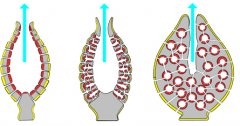
Name the increasing structural complexities seen above which are found in sponges.
|
• Asconoid - choanocytes line the spongocoel
• Syconoid - choanocyte chambers open into central spongocoel • Leuconoid - spongocoel replaced with extensive system of choanocyte chambers interconnected by canals |
|
|

Above image suggests that the Porifera phylum may be a _____ of all other metazoans?
|
• Sister group
|
|
|
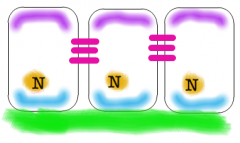
Name colored parts of above epithelial cells and explain what apicobasal polarity is.
|
• pink: intercellular junctions
• green: basal lamina • purple: apical surface • blue: baso-lateral surface • apicobasal polarity refers to the asymmetric organization of different aspects of the cell including the apical and basolateral regions, which are chemically and structurally different from each other |
|
|
|
Give order of Biological Classifications.
|
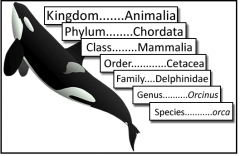
|
|
|

How does current-induced water flow through a sponge work?
|

• necessary to reduce energy require to create a current for feeding (via choanocytes)
• water flows in slowly through ostia at high pressure and flows quickly out osculum as it goes from H->L pressure • known as the bernoulli's principle P is proportional to 1/V |
|
|

Name the increasing structural complexities seen above which are found in sponges.
|
• Asconoid - choanocytes line the spongocoel
• Syconoid - choanocyte chambers open into central spongocoel • Leuconoid - spongocoel replaced with extensive system of choanocyte chambers interconnected by canals |
|
|
|
Hexactinellida (glass sponge) reef belts existed 145 million years ago in the late jurassic between Gondwana and North America ... it is thought that they have gone extinct 100 million years ago but have recently been found where?
|
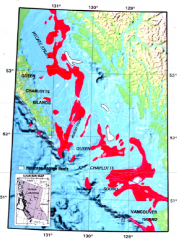
• discovered 20 years ago down in the Georgia straight off BC coast
• would have established 10 thousand years ago when conditions were right |
|
|
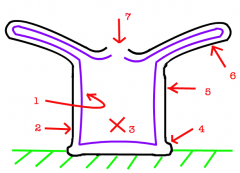
Identify labelled 1-7 above of a Cnidarian polyp body plan. State where tissue number 1 & 2 are derived from in the gastrula.
|
• 1 - gastrodemis derived from endodermis of gastrula
• 2 - epidermis derived from ectodermis of gastrula • 3 -gastrovascular cavity (GVC) • 4 - pedal disc • 5 - column • 6 - crown of tentacles • 7 - mouth |
|
|
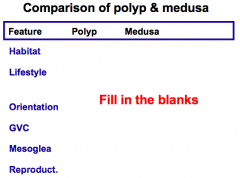
...
|

|
|
|
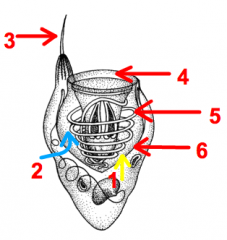
Name labelled parts of above cnidocyte cell and explain it's firing mechanism using arrows 1 & 2.
|
• 1 - Ca+ ions
• 2 - H2O molecules • 3 - cnidacil • 4 - hinged operculum • 5 - filament (=thread) • 6 - capsule • upon stimulation of cnidacil, Ca+ ions flow into cnidae nematocyst causing a osmotic pressure gradient across the nematocyst membrane pulling in H2O molecules rapidly and sending the filament firing out |
|
|
|
Explain Cnidaria life cycle - alternation of generation.
|
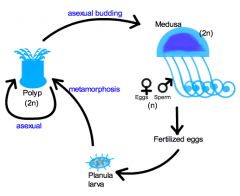
• adult male and female medusa produced fertilized eggs which form free-swimming planula larvae
• planula larvae find a substrate, becoming benthic, and for a scyphistoma polyp which strobilates by asexual reproduction • strobilating scyphistoma buds off ephyra which are again pelagic • ephyra grow into adult medusa |
|
|

Identify labelled 1-8 above of a Cnidaria Scyphozoa Aurelia body plan.
|
• 1 - gastric pouch
• 2 - gonads • 3 - perradial canal (branched) • 4 - rhopalia X 8 • 5 - interradial canal (branched) • 6 - adradial canal (non-branched) • 7 - oral arms X 4 • 8 - ring canal |
|
|
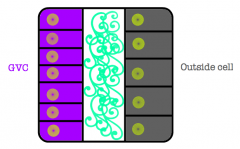
Name colored parts of above Cnidarian cells (polyp) and identify type of tissue.
|
• purple: gastrodermis - epithelial
• grey: epidermis - epithelial • aqua: mesoglea - connective |
|
|
|
Class Hydrozoa polyps may be colonial or solitary ... a colonial polyp such as, Obelia, is polymorphic and has 2 morphs - what are they?
|
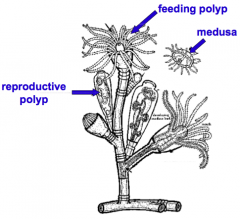
• reproductive and feeding
• organisms with 3 morphs include a defensive polyp |
|
|
|
What are the different kinds of epidermis cells found in the phylum Cnidaria?
|

• epitheliomuscle cells (red)
• nerve cells (blue) • gland cells • cnidocytes • interstitial cells - totipotent (?) |
|
|
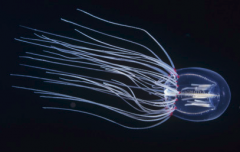
What is above jelly? What class can it be found in?
|
• polyorchis - red eyed jelly
• class Hydrozoa |
|
|
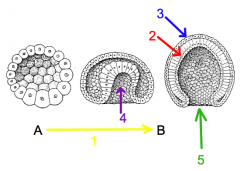
Identify 2-5, A&B, and what occurs between the two letters on the above diploblastic cell division diagram.
|
• A- blastula
• B - gastrula • 1 - gatrulation • 2 - endoderm • 3 - ectoderm • 4 - archenteron • 5 - blastophore |
|
|
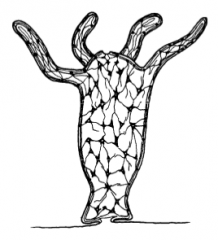
What can be said about the direction in which Cnidarian nerve nets fire?
|
• they are multipolar rather than dipolar like mammals
|
|
|
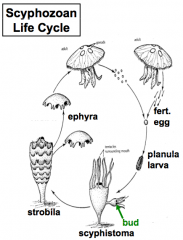
Where does asexual and sexual reproduction take place?
|
• asexual budding occurs and strobilation of scyphistoma produces genetically identical ramets called ephyra
• sexual reproduction occurs when male and female unique genotyped genets copulate their haploid sperm and eggs |
|
|
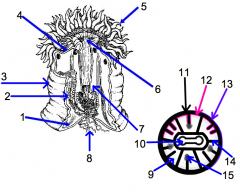
Identify labelled 1-15 of above sea anemone. What class and phylum is the sea anemone found in?
|
• Phylum Cnidaria; Class Anthozoa
• 1 - pedal disc • 2 - gonads • 3 - body column • 4 - oral disc • 5 - tentacles • 6 - mouth • 7 - pharynx • 8 - acontia - contain nematocytes which can be extruded through pores in body wall • 9 - coelenteron • 10 - siphonoglyphs • 11 - mesoglea • 12 - gastrodermis • 13 - epidermis • 14 - septa - incomplete or complete - also known as mesentery • 15 - gonads - extend down body column as shown in 2 |
|
|
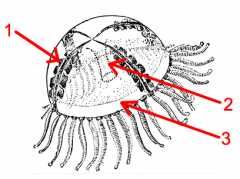
Identify labels 1-3 and determine what class the above jellyfish is from.
|
• Class hydrozoa (has velum)
• 1 - gonads • 2 - manubrium • 3 - velum This is a Gonionemus 'clinging' jellyfish. |
|
|
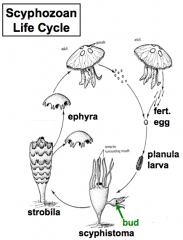
Where does asexual and sexual reproduction take place?
|
• asexual budding occurs and strobilation of scyphistoma produces genetically identical ramets called ephyra
• sexual reproduction occurs when male and female unique genotyped genets copulate their haploid sperm and eggs |
|
|
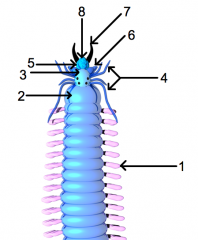
Identify labelled 1-8 of above Annelida and name the Family and Class.
|
• 1 - parapodia
• 2 - peristomia • 3 - prostomia • 4 - peristomial cirri • 5 - prostomial antennae • 6 - palp • 7 - jaw • 8 - extruded pharynx |
|
|
|
What are characteristics of subclass Zoantharia and what is another name for this subclass?
|

• tentacles in multiples of 6 which are not branched
• external CaCO3 |
|
|
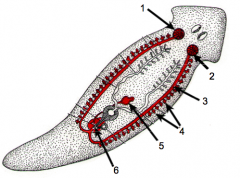
Identify female sexual reproductive parts of the hermaphroditic Turbellarian.
|
• 1 - ovary
• 2 - ovary • 3 - oviduct • 4 - yolk glands • 5 - copulatory bursa (sperm storage) • 6 - female gonopore |
|
|
|
What is the role of the siphonoglyphs found in sea anemones?
|

• inflation and deflation
|
|
|
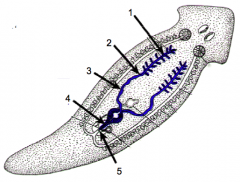
Identify male sexual reproductive part of the hermaphroditic Turbellarian.
|
• 1 - testes
• 2 - sperm duct • 3 - seminal vesicle • 4 - penis • 5 - male gonopore |
|
|
|
Explain the processes of protonephridia found in Platyhelminthes.
|
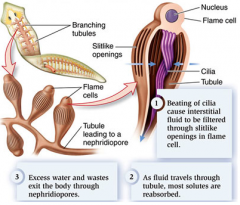
• Terminal cell (flame cell) -ultrafiltration
• Duct cells -selective reabsorption • Nephridiopore -release of waste |
|
|
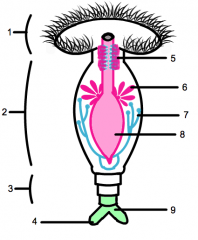
Identify 1-10 of above "wheel animacule".
|
• Phylum Rotifera
• 1 - ciliated corona • 2 - trunk • 3 - foot • 4 - toes • 5 - mastax with trophi • 6 - gastric glands • 7 - protonephridia • 8 - stomach • 9 - adhesive glands |
|
|
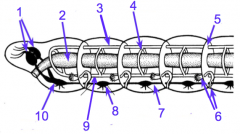
Identify labels 1-10 of above Annelida.
|
• 1 - cerebral ganglia
• 2 - digestive tract • 3 - dorsal blood vessel • 4 - segmental blood vessel • 5 - septa • 6 - metanephridia • 7 - ventral nerve cord • 8 - segmented ganglia • 9 - ventral blood vessel • 10 - subesophageal ganglia |
|
|
|
Describe the reproduction of the Phylum Rotifera.
|
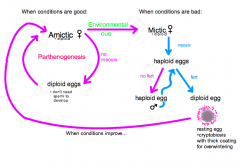
|
|
|
|
What are the characteristics of Nemerteans?
|
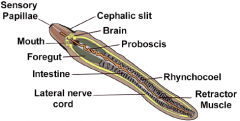
• mostly marine
• benthic • dorso-ventrally flattened with ciliated epidermis • predatory - proboscis apparatus • stylet with neurotoxins on proboscis • lateral blood vessels push blood with cilia rather than muscles • protonephridia |
|
|

Identify labelled 1-5 of above Trochophore larva. What does 3 become?
|
• 1 - eyespot
• 2 - apical sensory organ • 3 - prototroch ciliary equitorial band- becomes protomia in adult Polychaeta • 4 - mouth • 5 - anus |
|
|
|
How do annelids eucoelmic compartments circulate nutrients and gases?
|
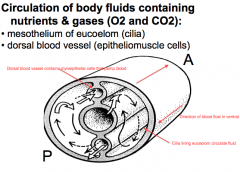
• ciliated eucoelom circulates fluids while epitheliomuscle cells in the dorsal blood vessel pump oxygen rich blood (bound by hemoglobin) throughout body
|
|
|
|
What are the characteristics of subclass Alcyonaria and what is another name for this subclass?
|

• tentacles are in multiples of 8 and they are branched
• internal CaCO3 |
|
|
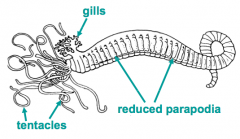
Name above Annelida and identify it's Class. Give some examples of it's characteristics.
|
• Terebellidae 'sphaghetti' worm of the Class Polychaeta
• selective surface deposit feeder • sedentary |
|
|
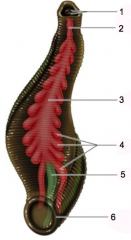
Identify labelled 1-6 of above Hirudinae.
|
• 1 - jaws
• 2 - pharynx (with dilator muscles) • 3 - crop • 4 - crop caeca • 5 - intestine • 6 - posterior sucker |
|
|
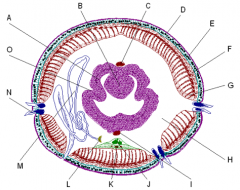
Identify labelled A-O of above Lumbricus cross section.
|
• A - gastrodermis
• B - typhlosole • C - dorsal blood vessel • D - cuticle • E - epidermis • F - circular muscles • G - longitudinal muscles • H - coelom • I - ventral blood vessel • J - ventral nerve cord • K - dont need to know ... subventral blood vessel • L - nephrostome • M - metanephridia • N - nephridiopore • O - chlorogogen tissue |
|
|
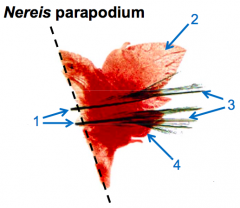
Identify labelled 1-4 on above Nereis parapodia.
|
• 1 - acicula - found specifically at ends of polychaeta chaetae
• 2 - notopodium (dorsal) • 3 - chaetae • 4 - neuropodium (ventral) |
|
|
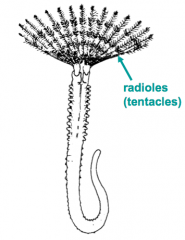
Name above Annelida and identify it's Class. Give some examples of it's characteristics.
|
• Sabellidae 'feather duster' worm of the Class Polychaeta
• suspension feeder • sedentary - lives primarily in it's secreted proteinaceous tube |
|
|
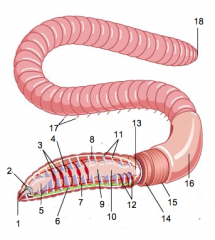
Identify labelled 1-18 of above Annelida and name the Family and Class.
|

• Class Oligochaeta Family Lumbricus
• 1 - mouth • 2 - cerebral ganglia • 3 - hearts • 4 - espophagus • 5 - pharynx • 6 - ventral nerve cord • 7 - ventral blood vessel • 8 - dorsal blood vessel • 9 - crop • 10 - gizzard • 11 - septa • 12 - metanephridia • 13 - intestine • 14 - longitudinal muscles • 15 - circular muslces • 16 - clitellum • 17 - setae • 18 - anus |
|
|
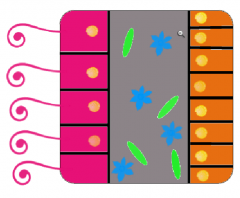
Name colored parts of above Porifera cells.
|

• pink: choanocytes
• orange: pinacocytes • blue: archaeocytes • green: spicules • grey: mesohyl • yellow: nuclei |
|
|
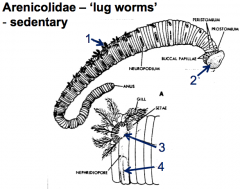
Identify labelled 1-4 of above Arenicolidae worm. What Class is this Annelida found in?
|
• Class Polychaeta
• 1 - gill • 2 - extruded pharynx • 3 - notopodium • 4 - neuropodium |
|
|
|
What two cold water coral provide important nursery habitats?
|
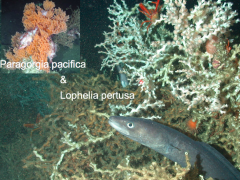
• Paragorgia pacifica found on N.E. pacific - octocorallian gorgonia (west coast)
• Lophelia pertusa found in the N. atlantic (east coast) - hexacorallian deepwater white coral |
|
|
|
What is necessary for multicellularity?
|
• Cell adhesion
• Cell specialization & interdependence - for cell signaling • Embryonic differentiation |
|
|
|
What are the characteristics of the phylum Porifera?
|
• no gut - interconnected system of water canals (aquiferous system)
• no nerve or muscle tissue • has connective & epithelial tissue (collagen 4) • non-self-recognition |
|
|
|
What are the habitats and lifestyles of the phylum Porifera?
|
• sessile
• suspension feeders • marine & freshwater (>2%) |
|
|
|
Where is the benthic zone?
|
• Sedimentary surface at bottom of a body of water
|
|
|
|
Metazoan tissue types?
|
• Epithelial
• Connective • Nervous • Muscle |
|
|
|
What is a sedentary lifestyle?
|
• Can move freely but doesn't very often
i.e. sea anemones |
|
|
|
Types of Lifestyles?
|
• Active
• Sedentary • Sessile |
|
|
|
What is another word for the spongocoel?
|
• atrium; central cavity of sponges
|
|
|
|
Where is the pelagic zone?
|
• Throughout the water column
|
• Greek - pélagos, which means "open sea"
|
|
|
What is pinacoderm?
|
• outer most layer of pinacocytes in the phylum Porifera, equivalent to the epidermis in other organisms
|
|
|
|
How do sponges hold their shape?
|
• spicules which can either be calcareous or siliceous or,
• fibers composed of the collagenous protein spongin |
|
|
|
Types of Habitats?
|
• Marine
• Freshwater • Terrestrial |
• Marine - regular osmolarity, fairly constant temp from day/night
• Freshwater - hypo-osmotic conditions, temp changes from day/night and seasonal • Terrestrial - threat of water loss through evaporation, temp changes day/night and seasonal |
|
|
Where are sclerocytes and spongocytes derived from?
|
• archaeocytes
- sclerocytes secret spicules - spongocysts produce spongin |
|
|
|
What are sponge choanocytes believed to be homologous with?
|
• protozoan choanoflagellates
|
|
|
|
What are the functions of sponge choanocytes?
|
• generate a water current that helps maintain circulation of water through sponge
• capturing of small food particles • capturing incoming sperm for fertilization |
|
|
|
Is the mesohyl of sponges living?
|
• no, it is nonliving and acellular (syncytial)
|
|
|
|
What are the functions of sponge archaeocytes?
|
• digestion of food
• secretion of waste • derive to become sexual cells • specialize to become spongocytes and sclerocytes - which act to secret supporting elements within the sponge |
|
|
|
What are the different classes found in the phylum Porifera?
|
• Calcarea - calcium carbonate spicules, asconoid/syconoid/leuconoid, exclusively marine
• Desmospongia - siliceous spicules and/or spongin, leuconoid, marine or freshwater • Hexactinellida (glass sponges) - chitin and 6-rayed siliceous spicules, pinacoderm and choanoderm are syncytial, syconoid/leuconoid, marine |
|
|
|
What distinguishes Calcarea from other sponges?
|
• calcium carbonate spicules
• only sponge with asconoid canal system |
|
|
|
What distinguishes Desmospongia from other sponges?
|
• spongin
• freshwater |
|
|
|
What distinguishes Hexactinellida from other sponges?
|
• 6-rayed siliceous spicules
• pinacoderm & choanoderm are syncytial |
|
|
|
What are the adhesion and signaling genes found in protozoan choanoflagellates?
|
• Cadherins & Tyrosine Kinases
|
|
|
|
Explain the steps involved in Porifera sexual reproduction.
|
• eggs mature in mesohyl
• sperm released from osculum of one sponge may be taken in by another where they are phagocytized by choanocytes = "smoking sponge" • choanocytes dedifferentiate to amoeboid form and transport sperm to mesohyl where fetilization of eggs takes place • fertilized eggs develop into ciliated larvae that are released from parent sponge • larvae swim briefly then settle on a substrate and undergo metamorphosis |
|
|
|
Do sponges reproduce sexually or asexually?
|
• both!
• sexually - hermaphroditic 'smoking sponges' widespread broadcast of spawning gametes taken in by other sponge choanocytes • asexually - budding/fragmentation or by gemmules (mainly in freshwater sponges) |
|
|
|
What are gemmules and what is their functional importance?
|
• gemmules are a form of asexual reproduction most commonly found in fresh water desmospongia
• archaeocytes secrete a thick round cover of spongin, reinforced with spicules, around themselves in the autumn right before the sponge dies (as the water temperature drops) • gemmules allow archaeocytes to 'overwinter', withstanding freezing, anoxia and drought |
|
|
|
How does a sessile Porifera defend itself?
|
• chemically through secondary metabolites which are unpalatable or toxic to predators or other organisms which they are competing with for space
|
Secondary metabolites?
|
|
|
Who are the recently discovered carnivorous sponges most closely related to?
|
• demosponges
• although these sponges do not have choanocytes, hook shaped spicules are present on its tendrils |
• Chondrocladia - new species of harp sponge in deep ocean
|
|
|
What are the habitats and lifestyles of the phylum Cnidaria?
|
• aquatic: marine and freshwater
• benthic and/or pelagic • solitary and/or colonial • predators |
• anemones, soft & hard corals, jellies, and hydroids
|
|
|
What are the major characteristic of the phylum Cnidaria?
|
• true gut
• diploblastic • radial symmetry • nerve net • cnidocytes • alternation of generations- polyp & medusa |
|
|
|
What are nematocysts?
|
• a type of cnidae within a cnidocytes that has a harpoon-like structure that is used to penetrate prey or predators
|
|
|
|
What advantage is there of being radially symmetric when your a sendentary organism?
|
• may obtain food and/or protect themselves around entire circumference
|
|
|
|
What 'generations' of Cnidaria are haploid and which are diploid?
|
• polyp and medusa are diploid
• gametes are haploid |
|
|
|
What are the different kinds of gastrodermis cells found in the phylum Cnidaria?
|
• nutritive muscle cells
• enzymatic gland cells • interstitial cells - totipotent • (cnidocytes) • (nerve cells) |
|
|
|
What are the different classes found in the phylum Cnidaria?
|
• Scyphozoa
• Hydrozoa • Anthozoa |
|
|
|
What distinguishes class Scyphozoa from others in the phylum Cnidaria?
|
• cnidocytes within both epidermis and gastrodermis
• ameboid cells within mesoglea • gametes originate from gastrodermis |
|
|
|
What distinguishes class Hydrozoa from others in the phylum Cnidaria?
|
• posses a velum
• cnidocytes only in epidermis • no ameboids in mesoglea |
|
|
|
What distinguishes class Anthozoa from others in the phylum Cnidaria?
|
• marine only
• polyp form only • cnidocytes within both epidermis and gastrodermis • ameboid cells within mesoglea • body wall turns in at mouth to form actinopharynx |
|
|
|
What subclasses exist within class Anthozoa? Give examples of each.
|
• Alcyonaria (Octocorallia) - soft corals, pipe corals, sea fans and sea pens
• Zoantharia (Hexacorallia) - sea anemones and true corals |
|
|
|
Colonial polyp forms of the class Hydrozoa found within the phylum Cnidaria include what?
|
• hydroids
• hydrocorals • siphonophores |
|
|
|
An atypical solitary polyp, which is exclusively freshwater, exists within Hydrozoa what is it?
|
• hydra
|
|
|
|
What does it mean to be diploblastic?
|
• only develop endoderm and ectoderm in gastrula - no mesoderm
• blastopore develops into mouth |
|
|
|
What are gastrozooids?
|
• polyps that capture and digest food - feeding polyps of Obelia (Class Hydrozoa Phylum Cnidaria)
|
|
|
|
What are gonozooids?
|
• polyps that bud off medusa - reproductive polyps of Obelia (Class Hydrozoa Phylum Cnidaria)
|
|
|
|
What is the hydrocaulus?
|
• 'stem' of the colonial Obelia (Class Hydrozoa Phylum Cnidaria)
|
|
|
|
What is the coenosarc?
|
• living tissue found within the perisarc (outer chitinous covering) of colonial Obelia (Class Hydrozoa Phylum Cnidaria)
|
|
|
|
What is the perisarc?
|
• chitinous tubes supporting the coenosarc living material in colonial Obelia (Class Hydrozoa Phylum Cnidaria)
|
|
|
|
What are hydrotheca?
|
• perisarc casing which encloses the hydranth - oral end of colonial Obelia polyps (Class Hydrozoa Phylum Cnidaria)
|
|
|
|
What is a hydranth?
|
• oral end of feeding Obelia polyp (Class Hydrozoa Phylum Cnidaria)
|
|
|
|
What does it mean to be triploblastic?
|
• endoderm, ectoderm, and mesoderm develop in the gastrula
• blastopore becomes anus |
|
|
|
What are the characteristics of hydrocoral (found in the class Hydrozoa)?
|
• calcium carbonate skeleton
• polyps rise up through pores of skeleton • have defensive, feeding (gastozooids), and reproductive (gonozooids) polymorphs |
|
|
|
What are the characteristics of siphonophores (class Hydrozoa)?
|
• pelagic
• highly polymorphed medusa and polyps • has a pneumatophore • medusa don't make gametes - only used for propulsion |
|
|
|
What are the characteristics of hydrocoral (found in the class Hydrozoa)?
|
• calcium carbonate skeleton
• polyps rise up through pores of skeleton • have defensive, feeding (gastozooids), and reproductive (gonozooids) polymorphs |
|
|
|
What are pneumatophores?
|
• floats full of carbon monoxide found in siphonophores (class Hydrozoa)
|
|
|
|
What are the characteristics of siphonophores (class Hydrozoa)?
|
• pelagic
• highly polymorphed medusa and polyps • has a pneumatophore • medusa don't make gametes - only used for propulsion |
|
|
|
What are pneumatophores?
|
• floats full of carbon monoxide found in siphonophores (class Hydrozoa)
|
|
|
|
What are genets and ramets?
|
• ramet - genetically identical (such as ephyra)
• genet - unique genotype (such as adult aurelia) |
|
|
|
What is the purpose of a velum and who posses it?
|
• Class hydrozoa
• velum is a muscular shelf around the periphery of the jellyfish which can change its size of aperture thus concentrating the water jet used for propulsion, it also allows more range of movement and allows jellyfish to manipulate the direction in which the water jet goes |
|
|
|
What is totipotent?
|
• cell which may spend different parts of life as different cell types
|
|
|
|
What is a nectophore?
|
• medusae that only participate in jet propulsion for locomotion - aka no sexual or feeding mechanisms
|
|
|
|
What is the common name for Physalia utriculus?
|
• man-o-war jelly
|
|
|
|
What is the common name for Cyanea capillata?
|
• lions mane jelly
|
|
|
|
What is the common name for Aurelia aurita?
|
• moon jelly
|
|
|
|
What subclasses exist within class Anthozoa?
|
• Alcyonaria (Octocorallia) - tentacles in multiples of 8 & are branched ... soft corals, pipe corals, sea fans, sea whips and sea pens
• Zoantharia (Hexacorallia) - tentacles in multiples of 6 & are non branched... sea anemones and true corals |
|
|
|
What relationship does Anthozoa have with zooxanthellae & zoochlorellae?
|
• symbiotic algal cells found in gastrodermis after they've been phagocytized sequester carbon via primary production and translocate it to host anemones, soft corals, sea whips and true coral
|
|
|
|
What are acrorhagi?
|
• Anthopleura elegantissima (common anemones on west coast - the purple and green ones) have specialized fighting tentacles called acrorhagi which inflate and are used to deter other colonies from encroaching on their space
• areas of identical clones arise from longitudinal asexual fission and there exist boarders of "no man's land" between different genotypes of A. elegantissima • all these anemones have acrorhagi but anemones found along boarders between other individuals tend to have more acrorhagi and reproduce less often |
|
|
|
What is the characteristics of Phylum Annelida?
|
• metamerism - segmentation
• eucoelomic compartments • has a blood vascular systems • metanephridia |
|
|
|
What are the defensive tentacles of Anthopleura Elegantissima called?
|
• acrorhagi
|
|
|
|
What is the generalized body plan of the Phylum Annelida?
|
• metamerism - segmentation
• eucoelomic compartments • blood vascular system • metanephridia - removes metabolic waste |
|
|
|
What are the 4 main functions of the eucoelmic compartments of Annelida?
|
• circulation of nutrients and gases
• hydrostatic skeleton • excretion and osmoregulation • storage of gametes |
|
|
|
Explain peristaltic movement of annelids. What annelid species shows a good example of this and what class and subclass are they found in?
|
• Lumbricus (earthworms) of Class Clitellata & Subclass Oligochaeta
• circular muscles contract putting pressure on the fluid-filled coelom and forcing the worm to stretch out • longitudinal muscles then contract pulling the body forward • setae (minimized chaetae) are used for slight traction during peristaltic burrowing |
|
|
|
What is the functional significance of metameres?
|
• segmentation of the fluid-filled coelom facilitates regional pressure differentials; without them fluid would spill into the entire part of body during peristaltic burrowing and it aids in circulation
|
|
|
|
What do annelids use as an excretory and osmoregulatory system?
|
• metanephridia
• coelomic body fluids are drawn in via ciliated internal nephrostomes and solutes are selectively reabsorbed and re-enter through capillaries surrounding the metanephridia • excess water creates dilute urine and the nitrogenous wastes are excreted through external nephridiopores |
|
|
|
What is a nephrostome?
|
• internal opening to metanephridia found in annelids
• nephrostome is located in anteriorly adjacent metamere |
|
|
|
What is a nephridipore?
|
• external opening to metanephridia found in annelids
|
|
|
|
What Classes exist in the Phylum Annelida?
|
• Polychaeta - have parapodia with cheatae hairs and are diocious
• Clitellata - no parapodia but setae hairs, have clitellum and are hermaphroditic |
|
|
|
What Subclasses exist within Class Clitellata?
|
• Oligochaeta - Lumbricus (earthworm)
• Hirudinea - Hirudo (leeches) |
|
|
|
What is the difference between chaetae and setae?
|
• chaetae are chitinous hairs on parapodia
• setae are chitinous hairs not on parapodia |
|
|
|
Give examples of active forms of the Class Polychaeta.
|
• Nereids
• Glycerids |
|
|
|
Give examples of sedentary forms of Class Polychaeta.
|
• Arenicolids
• Sabellids • Terabellids |
|
|
|
How do Polychaeta reproduce?
|
• asexual budding occurs
• epitoky - swarming behavior • sexual broadcast spawning of gametes into seawater as well as swarming to further enable fertilization |
|
|
|
What is epitoky and what kinds are there?
|
• morphological transforming of Polycheata to enable copulation: enlargement of parapodia for swimming, enlargement of eyes for light cue (possibly lunar), eucoelomic cavity full of gametes in preparation for swarming
• direct transformation • posterior transformation • or serial budding of epitokes |
|
|
|
What is the function of chloragogen cells?
|
• found in Oligochaeta chloragoen cells perform similar functions to the livers of vertebrates
• glycogen & fat synthesis and storage • hemoglobin synthesis • proterin catabolism and urea synthesis |
|
|
|
What are characteristics of Hirudinea?
|
• Phylum Annelida, Class Clitellata, Subclass Hirudinea - leeches
• no parapodia • clitellum • hermaphroditic • no setae • anterior & posterior suckers • dorso-ventrally flattened • fixed number of metameres (33) • specializations for ectoparasitism |
|
|
|
What specialized features do Hirudinea have for ectoparasitism?
|
• thickened cuticles of Y shaped blades = jaws
• dilator muscles of pharynx • hirudin - an anticoagulant which prevents blood cloating • crop caeca to increase volume of 'stomach' for incoming blood • anesthetic so prey doesn't feel pain |
|
|
|
What is the rhynchocoel?
|
• circular muscle sac surrounding proboscis of the Nemertean Phylum
|
|
|
|
How do Nemerteans reproduce?
|
• dioecious
• have transient gonads • broadcast spawn • have free swimming larva |
|
|
|
What is the Phylum Aschelminthes?
|
• 'ash-tray' phylum where many other phylums were put until there were successfully genotyped and phylogenetic relationships were established
|
|
|
|
What does being eutely mean?
|
• eutelic organisms have a fixed number of cells when they reach maturity; therefore further growth only occurs via cell enlargement
|
|
|
|
Give characteristics of the Phylum Rotifera.
|
• pseudocoelomate
• eutely • syncytial tissue • lorica - not a cuticle; keratin-like protein fibres can be thin and flexible or thick and rigid • has longitudinal and circular muscles • swims with ciliated corona • cryptobiosis |
|
|
|
Give characteristics of Class Turbellaria of the Phylum Platyhelminthes.
|
• bilateral symmetry
• triploblastic • acoelomate • gastrovascular system with only one opening • dorso-ventrally flattened • cephalic ganglia and long nerve cords • protonephridia for excretion and osmoregulation |
|
|
|
What Classes exist in the Phylum Platyhelmintes.
|
• Turbellarian - free living
• Trematoda - endoparasitic • Cestoda - endoparasitic |
|

